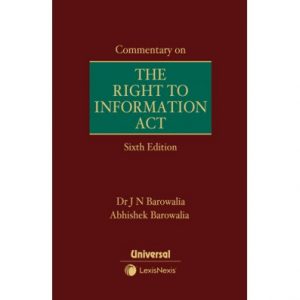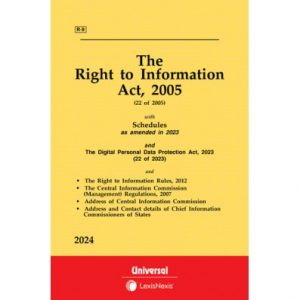Right to Information Act, 2005

In India the foundation of democracy is upheld by transparency and trust in governance. The Right to Information Act of 2005, hereinafter referred to as the (“RTI Act”) plays a major role in this belief allowing all citizens to request information, from government bodies promoting responsibility and effective administration. This important legislation revolutionized governance by giving citizens the right to request for and receive information from public bodies. In this blog, we will explore the history, objectives, crucial features along with substantial provisions of the Act and we have also recommended books related to right to information act.
Historical Background
The demand, for the Right to Information Act, 2005 in India stemmed from a desire for transparency and accountability in governance. The significance of the right to information was highlighted when the Universal Declaration of Human Rights (UDHR) was established in 1948 guaranteeing individuals the liberty to access information and ideas freely without any limitations. International Covenant on Civil and Political Rights (ICCPR), 1966 asserts that everyone should enjoy the freedom to express themselves and have access, to a variety of information and ideas.
The Supreme Court (SC) in the important case of State of UP Vs Raj Narain held that transparency is a crucial part of democracy and citizens should have the right to access records and information of government entities under the ambit of Article 19 of the Constitution. In the 1990s, a movement, for justice took place in Rajasthan led by activists like Aruna Roy and Nikhil Dey through the Mazdoor Kisan Shakti Sangathan (MKSS). The Mazdoor Kisan Shakti Sangathan (MKSS) launched initiatives to establish foundations and put into practice the idea of the Right to Information.
What is the Right to Information Act, 2005?
The Right to Information Act, 2005 is a crucial law established by the Parliament in 2005 under the democratic principles of transparency, accountability and trust. It has provided citizens with a path towards a more active participation in a democratic country like India.
According to the RTI Act, any Indian citizen has the authority to request information from an entity, which is accountable to furnish the requested details within a timeframe. The legislation encompasses public authorities and control of public authorities.
Key objectives of Right to Information Act, 2005
The RTI Act was formulated keeping in mind various key objectives of the democracy. They are as follows: –
Empowerment of citizens:
The Right to Information Act gives people the right to access information allowing them to play an active role, in democratic processes. This helps individuals make informed decisions interact with policies and ensure that public officials are responsible, for their deeds.
Transparency and openness:
The RTI Act aims to boost openness in how government institutions operate by granting citizens access, to information held by government and national bodies. Its goal is to reduce secrecy and increase oversight of government choices and activities.
Battle against and to prevent corruption:
Transparency and accountability play a role in the fight, against corruption. The Right to Information (RTI) Act acts as an instrument in uncovering government practices and ensuring those responsible for corruption are held answerable. By granting citizens access to details concerning government contracts, spending and decision-making processes the Act aids, in pinpointing cases of corruption and fostering responsibility.
Features of the Right to Information Act, 2005
RTI Act serves as a cornerstone of transparency and accountability in the system. This law gives each individual the ability to engage actively by providing them with the privilege to obtain data that public bodies hold. What specifically attributes to the strength of the RTI Act? Let’s explore its features:
Access to information through legal route:
The RTI Act provides all citizens with the entitlement to access information which are held by government bodies with some exceptions and limitations outlined in the law.
Wide coverage:
The law applies to every government department, ministry, public sector enterprises, NGOs which have got substantial funding from government and other entities established either by the Constitution or, through legislation. It extends its reach to both state government organizations guaranteeing information access nationwide. However, National intelligence and security agencies of the government are excluded from the scope of this act.
Streamlined application process (physical and electronically):
Indian Citizens have the option to submit an RTI request either in written application form or electronically detailing the information they are seeking from the government agency. Along with the request application a small fee, which differs based on the data requested must be paid.
Availability of time bound responses:
Government agencies must reply to RTI requests, within 30 days of receiving them. If the information requested pertains to someone’s life or liberty, then the response time is shortened to 48 hours. If you are not satisfied with the response, then you have an option to file an appeal to the First Appeal Authority (FAA).
Significant provisions of the Right to Information Act, 2005
This revolutionary law gives each individual the ability to uncover the information held by government bodies. What provisions contribute to the effectiveness of the RTI Act, as a powerful instrument? In this part of our blog, we will discuss the significant provisions which make this act intriguing.
1. Section 2(c) of the Act: This section pertains to the definition of the Central Public Information Officer. A Central Public Information Officer (CPIO) is an official designated by an agency, in India under the Right to Information (RTI) Act of 2005 at the level. The key responsibility of the CPIO is to support the enforcement of the RTI Act, within their agency.
2. Definition of Public authority under Section 2(h) of the Act: According to the Act, “Public authority” refers to any entity or organization of the Government that is set up or formed under the Indian Constitution through legislation passed by Parliament or a State Legislature or by an announcement or directive, from the relevant government body.
3. Section 4 – the Right to Information and obligations of Public Authorities: This part outlines the disclosure rules, for government agencies. It directs these agencies to keep records and share types of information on their websites or other platforms making it easier for the public to access. Government bodies should make an effort to proactively share information, with the public regularly using communication channels.
4. Section 6- Request for obtaining information: This section explains the process of requesting information. It states that any citizen who is in requirement of such information shall make a request application (written or digital) in Hindi or English or in the official language which is used in the area where such information is requested and shall pay a nominal applicable fee along with the request to the CPIO or SPIO.
5. Section 8 – Grounds for rejection of RTI requests: As per the section, the following information falls outside the scope of the RTI Act, 2005.
- Matters concerning the sovereignty and integrity of India as the security, strategic, scientific or economic interests of the nation, relationships with foreign states, commercial confidentiality, trade secrets or intellectual property protection or any information that could jeopardize someone’s life or physical wellbeing;
Amendments to the Act
The primary goal, behind amending the RTI Act was to exclude political parties from its jurisdiction. Consequently, Parliament decided to amend the act and introduced the RTI Amendment Bill, 2013. Unfortunately, the bill did not progress as it lacked approval, from both houses of Parliament.
Then in 2019, there was another attempt in amending the Act through the RTI (Amendment Act) of 2019 which subsequently granted the Central Government the power to decide how long Information Commissioners can be in service, how much their salary and other benefits should be in monetary terms and other conditions of work.
Information that can be requested
Under the provisions of the Right to Information (RTI) Act of 2005 in India individuals have the privilege to request access to data maintained by authorities. This encompasses an array of categories including:
1. Info on Government policies and decisions: Individuals can seek information regarding government policies, decisions and the underlying reasoning behind them.
2. Government Initiatives: Information pertaining to government programs, initiatives and their execution can be requested.
3. Spending and budgets: Individuals have the right to inquire about public expenditure, budget allocations and how funds are utilized by government departments and agencies.
4. Records and official documents: Access can be sought for official records, documents, reports, memos, emails and any other pertinent information held by public authorities.
5. Project specifics: Details concerning public projects, contracts, tenders, agreements – including contractor details and beneficiaries – are open for inquiry.
6. Personnel related data: Information on government officials such as their salaries allowances promotions transfers can be requested.
7. Safety and health matters: Individuals can seek information, on public safety protocols health programs sanitation facilities and other relevant public health issues.
Furthermore, you can ask for details on cases and court decisions, rulings and legal viewpoints.
Commentary on the Right to Information Act by Dr. J N Barowalia & Abhishek Barowalia

This book on the RTI Act, 2005 is detailed and reliable resource providing a review of each section of the Act along with commentary to aid in understanding and interpreting the law. It includes an in-depth reference, to court decisions and judicial amendments and updates.
The book has got some important features like:
- Wide range of issues have been considered and explained in a comprehensive manner.
- Incorporates The Digital Personal Data Protection Act, 2023
- Includes important judicial developments and recent legislative changes.
Right to Information Act, 2005 along with allied Rules and Regulations

The bare act of the RTI Act published by LexisNexis is a comprehensively explained book that gives you a proper understanding of the act along with easy concepts of RTI Rules, The Central Information Commission (Management) Regulations, 2007.
Conclusion
The RTI Act of 2005 is a crucial law that embodies values like transparency, accountability and citizen empowerment in governance. It promotes openness and responsiveness in governance thereby bolstering institutions and fostering trust in the government. Nevertheless, there are hurdles such as tackling delays in handling RTI requests, raising awareness about the Act, among citizens and improving mechanisms for implementing it to prevent any misuse or exploitation of the law. By embracing the principles of the Act and working towards its execution we can unlock its benefits in nurturing a democratic society that is well informed.
FAQs
1. What are the main points of the RTI Act?
Transparency, accountability, democracy and trust are the main points.
2. What is the Right to Information Act 2005?
The RTI Act, 2005 stands as a landmark law that grants individuals the right to obtain information held by government entities.
3. In which case RTI can be rejected?
As per section 8, RTI can be rejected if it comes under the sovereignty and integrity of the nation as well as the strategic, security, or economic interests of the state.
4. What are the disadvantages of RTI?
Disadvantages include misuse or abuse of the right for personal vendettas and privacy concerns.

